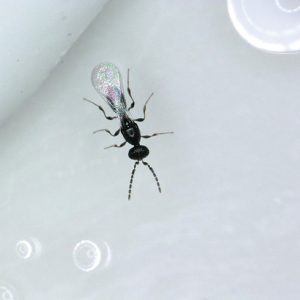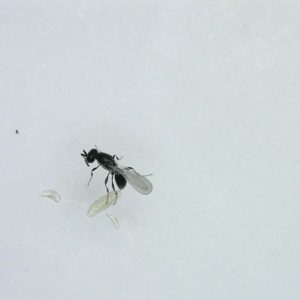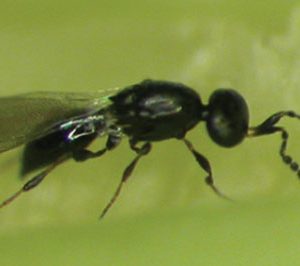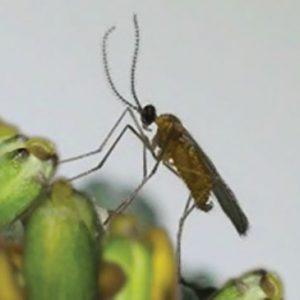
Features
Canola
Insect Pests
Tackling a tiny but tough canola pest
Highlights from some recent swede midge research.
October 14, 2021 By Carolyn King
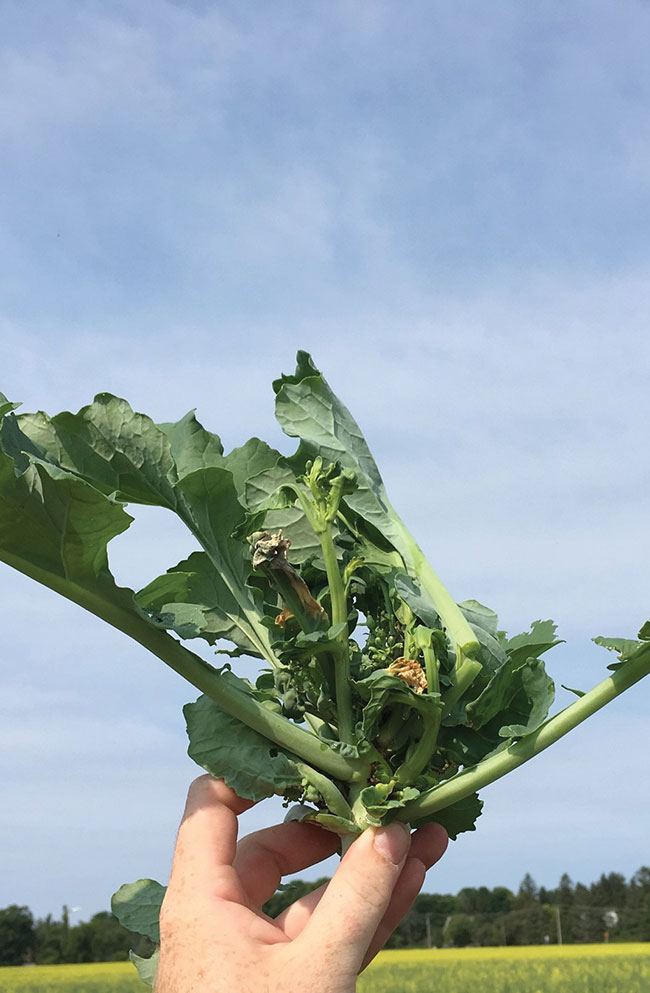 An example of swede midge damage in canola.
All photos courtesy of Charles-Étienne Ferland.
An example of swede midge damage in canola.
All photos courtesy of Charles-Étienne Ferland. Swede midge is one of the newest and most serious concerns for canola production in Ontario. Since this tiny Eurasian fly was first confirmed in North America in 2000, Rebecca Hallett and her research group at the University of Guelph have been working on this extremely challenging pest. Their latest studies are making further advances in integrated pest management (IPM) options for growers.
A highly successful pest
Swede midge (Contarinia nasturtii) is a pest of cruciferous crops like canola, cabbage and broccoli, and cruciferous weeds like shepherd’s purse. After overwintering, the adult flies emerge from the soil. The females lay their eggs in areas of new growth on host plants. The larvae feed on the growing plant tissues. Then they pupate in the soil, and in a few weeks, the next generation of adults emerges.
For many Ontario canola growers, symptoms of swede midge damage are all too familiar, such as crinkled leaves, malformed buds, bunching of pods, and stunted or dead plants.
“When the pest’s population is very high, the yield impact can be about 50 per cent. But that impact can be difficult to quantify because swede midge will attack canola throughout the season. Wherever there are growing points, canola is vulnerable,” Hallett explains.
“The actual impact will depend on the timing of the infestation, the number of swede midges on the plant, and the plant’s response. Our research shows canola will produce additional growth in response to swede midge damage, which might compensate for yield. However, this additional growth can lead to very variable maturation timing, which could complicate harvesting.”
Over the past two decades, swede midge has spread through the canola-growing regions of Eastern Canada and the eastern United States. Unfortunately, the pest has many characteristics that make it very tough to control.
“The larvae feed within swelling and twisting plant tissues, making insecticide penetration difficult,” Hallett says. “Also, the pest has multiple overlapping generations. [In Ontario] it is present from mid-late June to September. It has multiple emergence phenotypes, with the different types emerging from overwintering at different times. So, even if one very effectively controls all of the midges up to a certain point in the season, some could still emerge from overwintering later. Also, they go into diapause for overwintering at different timings through the season, which means there will always be an overwintering population. This very variable life cycle allows the insect to persist in unpredictable environments, making it a really successful pest.”
Earlier research by Hallett’s group developed various tools for swede midge management, including insecticide strategies and several cultural control options. For example, crop rotation and crop diversification are really important. Early seeding of spring canola may help, unless cabbage seedpod weevil is a bigger problem than swede midge in the grower’s area. Also, growing winter canola can be a good option for some growers.
In the last few years, Hallett’s swede midge-related research has included looking into how to encourage the presence of a natural enemy of swede midge, fine-tuning insecticide strategies, and improving a predictive tool.
Fine-tuning thresholds
Previous research by Hallett’s group developed pheromone trap-based thresholds for insecticide applications, with the first applications timed for the first peak of swede midge emergence.
Based on recent lab experiments and field trials, the researchers have now tweaked the thresholds for canola. “We had been using a tentative action threshold of waiting to make the first spray until there was a cumulative trap capture of at least 20 midges across four traps in a field. Once that threshold was exceeded, then subsequent insecticides would be applied when the threshold of an average of five or more males per trap per day had been reached, with at least a seven-day interval between applications,” she explains.
“We’ve lowered the application threshold from five males per trap per day, to three males per trap per day. From a canola grower’s perspective, it’s not a major change.”
One reason for lowering the threshold is that growers may want to avoid letting the pest’s population get to the point where the canola plants start compensating for the damage because of the potential for harvest complications.
The lower threshold also provides an earlier warning to growers. If swede midge populations are high, then trap counts can jump from three to five to 10 very quickly, and growers may need time to arrange for custom spraying.
Hallett’s group also compared the efficacy of threshold-based and plant stage-based approaches to timing insecticide applications. They found that both were effective at preventing swede midge damage and protecting yield. However, the plant stage approach would always result in three insecticide applications, whereas the threshold approach usually resulted in only two applications, making it more economical for growers.
Parasitoid versus pest
Much of Hallett’s recent research has focused on a natural enemy of swede midge called Synopeas myles. This wasp is native to Europe, where it parasitizes swede midge as well as other midges. The female wasps lay their eggs in swede midge larvae. Then the wasp larvae feed on the midge larvae, eventually killing the midges.
“Having a biological control component is a really important part of an IPM strategy. For many years, swede midge didn’t seem to have any natural enemies here,” Hallett notes. Then in 2016, her group found Synopeas myles in Ontario.
Since then, the researchers have been gathering information on things like the parasitoid’s life cycle in Ontario, its geographical distribution, and its effectiveness in controlling the midge. These studies have received support from the Ontario Canola Growers Association (OCGA), the Eastern Canada Oilseeds Development Alliance (ECODA) through the Canadian Agricultural Partnership and Agriculture and Agri-Food Canada (AAFC), the Ontario Agri-Food Innovation Alliance, Bunge and Bayer.
Hallett’s group is collaborating with several researchers on these studies, including Boyd Mori, now at the University of Alberta, Sebastien Boquel with CÉROM (Centre de recherche sur les grains) in Quebec, and Meghan Moran with the Ontario Ministry of Agriculture, Food and Rural Affairs (OMAFRA). Their field surveys so far show Synopeas myles is very widely distributed across Ontario’s canola-growing regions, occurring in almost every county where canola is grown. The wasp is generally found around the edges of cruciferous fields, which makes sense because swede midge is an edge pest. The surveys have also found another parasitoid wasp in some samples, so more help in controlling swede midge larvae might eventually be available.
Flowers for a natural enemy
The researchers’ studies on the impact of Synopeas myles on swede midge populations have found average parasitism rates of about six per cent of the hosts, although the rates can be as high as about 30 per cent.
“A parasitism rate of six per cent is not enough to be a limiting factor for swede midge populations. But rates of 30 per cent or higher could become a more important part of an IPM strategy,” Hallett notes.
Therefore, the researchers have been investigating how to increase the wasp’s impact on swede midge numbers.
They have found that higher parasitism rates tend to occur in fields that are surrounded by managed land and have wildflowers in the field edges. “The adult wasps feed on nectar from flowering plants. We found that if we provided them with a sugar solution or with flowering sweet alyssum, which is a nectar-providing plant, then the adults would live longer than if they had access just to water, for example,” she notes. Their subsequent studies suggest that having a longer life allows the females to find more swede midge larvae in which to lay their eggs.
So, if growers are interested in increasing the wasp’s effectiveness at controlling the midge, they could deliberately plant nectar-producing flowers, such as sweet alyssum, along the field edges or simply allow wildflowers to bloom along the edges.
Insecticides and the parasitoid
Hallett’s group also examined how insecticides registered for use on canola affect the wasp. In lab experiments in Petri dishes, they compared the equivalent of half, full, and double the label rates of these insecticides.
“First we looked at direct exposure to the insecticide. Matador (lambda-cyhalothrin) killed 100 per cent of the wasps at each of the rates. Coragen (chlorantraniliprole) had five to 15 per cent mortality, so it presents a lower risk than Matador. We also did the experiments with Movento (spirotetramat); it is not registered for use in canola, but is registered for use in cole crops. Like Coragen, direct contact mortality with Movento was five to 15 per cent. Then we looked at how long the residues remained toxic to the wasp. For Matador, we were still getting very high levels of mortality – 90 per cent plus – up to seven days later.” These lab estimates may be higher than the mortality levels that actually occur in the field.
“Growers who want to encourage the presence of Synopeas should likely avoid using Matador or at least avoid applying Matador when the wasp is likely to be most abundant,” Hallett advises.
“This fits with our recommendation that, if you are going to use Matador, then use it as the first spray in the season, because the wasp first starts arriving in canola fields a little later than the first arrival of swede midge.”
Predicting a very variable pest
About a decade ago, Hallett’s group developed an initial model of the midge’s life cycle, called MidgEmerge. “With that first model, we were only interested in predicting when the peaks of adult emergence would occur, so it could be used as a signal for growers to be prepared to start applying insecticides,” she says. “Back then, we were basically using information on swede midge life history, development times, and so on from studies in the United Kingdom in the 1960s. Our model was only somewhat accurate in predicting when the adults would emerge here.”
Since then, Hallett’s students have been investigating many aspects of the pest’s life history and ecology in Ontario, such as the factors affecting the timing of emergence, egg-laying rates on canola, overwintering survival, mortality, and attacks on the midge by its natural enemies.
With this more comprehensive and directly relevant information, Hallett and her group recently looked at the temperature-related development and survival of every life stage of swede midge under Ontario conditions. Then they used that to develop a new model, MidgEmerge2.
According to Hallett, MidgEmerge2 is very good at predicting the timing of the pest’s first emergence after overwintering and pretty accurate at predicting the timing of the first strong peak of emergence. So, for instance, the model could be used with regional weather forecasts to make regional swede midge projections. However, she emphasizes that growers should always use swede midge pheromone traps to confirm their local populations for spraying decisions.
The MidgEmerge2 research has also improved understanding of the pest’s biology and ecology in Ontario. Hallett gives one example: “For many years, we thought swede midge in Ontario had three to five overlapping generations with probably two emergence phenotypes – early and late emergers in the springtime – and maybe a third phenotype. However, this modelling shows that we definitely have three emergence phenotypes, two in the spring and one later in the summer. Also, it looks like we have two to three generations per year, not three to five.”
Her group is also looking at using MidgEmerge2 to predict regional outbreaks. Their research so far indicates that, when very high numbers of adults coincide with high temperatures, egg-laying will be higher than normal. This higher egg-laying results in greater damage in the current year and in outbreaks in the following year.
On the lookout for another midge
Hallett’s group is also interested in the canola flower midge (Contarinia brassicola). This recently discovered species was first found on the Prairies, where it causes tubular flower galls in canola.
“We have been looking for the canola flower midge in Ontario for a number of years, but we have never seen those tubular flower galls. However, Boyd Mori has provided us with pheromone traps specific to the canola flower midge. We are now collecting samples and we still need to confirm identifications, but it does appear that this midge is in Ontario,” she notes.
If it is confirmed in Ontario, then Hallett would like to determine which plant species are hosts for the canola flower midge and whether Ontario growers need to be concerned about it.
“The canola flower midge appears to be a native species that, after intensive canola production on the Prairies for many years, has adapted to using canola as a host. Whether this midge has always been present in Ontario and hasn’t made the shift to canola, or whether it has been spreading from the Prairies, we don’t know. We need to do those kinds of assessments.”
No silver bullets
“I’m certain that we’ll never have a silver bullet for tackling swede midge. It will always require constant attention to a range of integrated pest management practices,” Hallett emphasizes.
The OCGA has provided funding for Hallett’s swede midge research for many years. “Swede midge has been an incredibly devastating pest in parts of Ontario on the spring canola crop…We are very fortunate to have someone of Dr. Hallett’s expertise in our backyard,” says Jennifer Doelman, an OCGA director, farmer and Certified Crop Adviser. “Research like this is essential to the long-term sustainability of Canadian agriculture: gone are the days when all solutions come out of a bag or a jug – and I think that’s OK. It’s great to have these tools in our toolboxes.
“Today’s farmers are leaders in being able to manage a myriad of changing factors – weather, markets, technology and ecology – to best navigate the challenges of each cropping season to help produce the safe, quality canola that Canada is recognized for around the world,” Doelman adds. “We need research like this to help guide our decision-making processes.”
